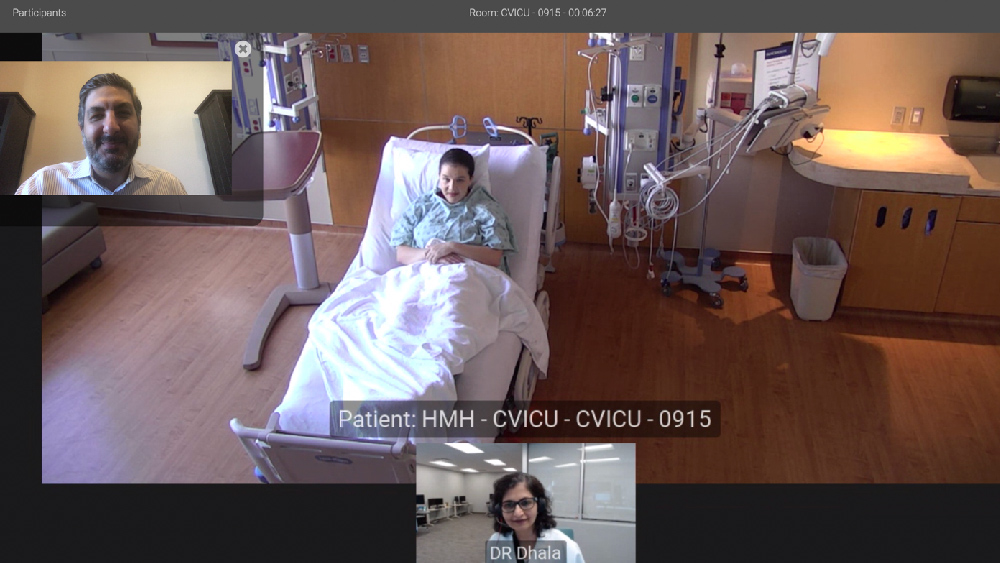
A new process was designed and rapidly implemented to allow family members to book a visit virtually with their loved ones in intensive care. |
Image: Getty Images
During the start and onrush of the COVID-19 pandemic, all hospitals in the state of Texas restricted visitation for intensive care unit (ICU) patients and their families because of the infectious nature of the virus.
Family members were unable to visit, or even communicate, with their loved ones, leaving many individuals with feelings of anxiety, confusion and fear of the unknown.
A group of doctors from Houston Methodist and researchers from Texas A&M University identified a novel approach of adapting a virtual ICU, or vICU, to make family visitations possible. The vICU involves physiological sensors that are monitored 24/7 in the operations center of the hospital. The system also includes two-way audio/video communication technology. In the past, this technology has been reserved for virtual visits by doctors and consultants, but it was instrumental in connecting ICU patients with their family members, especially when dealing with the highly infectious coronavirus.
A new process was designed and rapidly implemented to allow family members to book a visit with their loved ones virtually. After speaking to a Virtual Registered Nurse (vRN), family members receive a link in a text, which would connect them to the audio/video equipment installed in the patient’s room.
Family members were unable to visit, or even communicate, with their loved ones, leaving many individuals with feelings of anxiety, confusion and fear of the unknown.
A group of doctors from Houston Methodist and researchers from Texas A&M University identified a novel approach of adapting a virtual ICU, or vICU, to make family visitations possible. The vICU involves physiological sensors that are monitored 24/7 in the operations center of the hospital. The system also includes two-way audio/video communication technology. In the past, this technology has been reserved for virtual visits by doctors and consultants, but it was instrumental in connecting ICU patients with their family members, especially when dealing with the highly infectious coronavirus.
A new process was designed and rapidly implemented to allow family members to book a visit with their loved ones virtually. After speaking to a Virtual Registered Nurse (vRN), family members receive a link in a text, which would connect them to the audio/video equipment installed in the patient’s room.

Drs. Farzan Sasangohar and Atiyah Dhala testing the vICU system for visitation. |
Image: Courtesy of Farzan Sasangohar
This improvised solution was important, since bringing in outside technology such as phones or tablets into the ICU was no longer possible because it posed sanitation threats and subjected medical staff to much higher risks of infection. Often, patients weren’t able to use everyday technology themselves due to sedation and intubation restrictions, and would require assistance from medical staff to use this particular equipment.
Using vICU technology not only provided more accessible technology for the patient, but also posed less of a risk of infection for health care workers, even though some patient assistance could be needed, depending on the severity of the patient’s condition.
“We needed to think outside the box and use something that wasn’t intended for this purpose at all,” said Dr. Farzan Sasangohar, assistant professor of industrial and systems engineering at Texas A&M. “This is an example of effective improvisation and adaptation, which are key characteristics of resilient health systems. We know from the literature that family engagement is extremely important. It has positive impacts on patient outcomes.”
To evaluate this improvised solution, the research team interviewed 230 family members after using this technology to communicate with their loved ones, and overall, the responses were very positive, albeit emotional.
A majority of users reported feelings of joy and relief being able to see their family member. Still, there were reports of sadness with family members seeing their loved one in a difficult situation, particularly when the patient was intubated or unable to speak.
There were also some responses recorded from family members who lost their loved ones while in ICU, and reported that they were grateful to have had this option to see them and get closure.
Some users reported potentially making this available on demand to enable initiating calls on their own.
The adoption of a vICU for family visitation shows promise during an unusual and trying time for many. However, several areas for modification and improvement were identified that need to be addressed.
“I believe our family-centered approach provides an opportunity to take us closer to a real open-ICU concept in which family members are engaged more efficiently and effectively,” Sasangohar said. “This will have a significant positive impact on patient outcomes.”
Using vICU technology not only provided more accessible technology for the patient, but also posed less of a risk of infection for health care workers, even though some patient assistance could be needed, depending on the severity of the patient’s condition.
“We needed to think outside the box and use something that wasn’t intended for this purpose at all,” said Dr. Farzan Sasangohar, assistant professor of industrial and systems engineering at Texas A&M. “This is an example of effective improvisation and adaptation, which are key characteristics of resilient health systems. We know from the literature that family engagement is extremely important. It has positive impacts on patient outcomes.”
To evaluate this improvised solution, the research team interviewed 230 family members after using this technology to communicate with their loved ones, and overall, the responses were very positive, albeit emotional.
A majority of users reported feelings of joy and relief being able to see their family member. Still, there were reports of sadness with family members seeing their loved one in a difficult situation, particularly when the patient was intubated or unable to speak.
There were also some responses recorded from family members who lost their loved ones while in ICU, and reported that they were grateful to have had this option to see them and get closure.
Some users reported potentially making this available on demand to enable initiating calls on their own.
The adoption of a vICU for family visitation shows promise during an unusual and trying time for many. However, several areas for modification and improvement were identified that need to be addressed.
“I believe our family-centered approach provides an opportunity to take us closer to a real open-ICU concept in which family members are engaged more efficiently and effectively,” Sasangohar said. “This will have a significant positive impact on patient outcomes.”